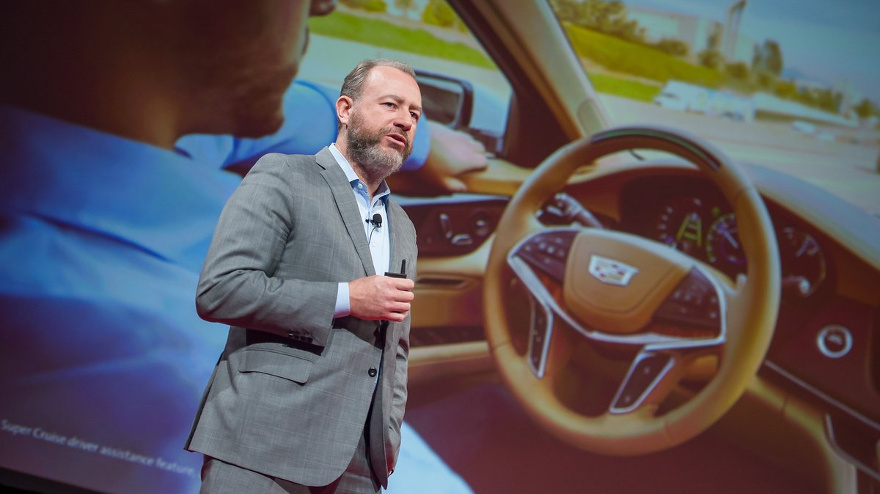GM more upbeat about used market than a year ago

General Motors president Dan Ammann at the Vehicle Finance Conference hosted by the American Financial Services Association on March 21 in Las Vegas. (Photo courtesy of AFSA)
By subscribing, you agree to receive communications from Auto Remarketing and our partners in accordance with our Privacy Policy. We may share your information with select partners and sponsors who may contact you about their products and services. You may unsubscribe at any time.
LAS VEGAS –
General Motors president Dan Ammann acknowledged the situation involving overall off-lease volume in the wholesale market and how the automaker and its captive — General Motors Financial — set residual values created some notable stress.
“We were just saying last night that when we were together a year ago, we were quite concerned, but we feel a lot better about it now,” Ammann said during a conversation with industry media after his opening keynote presentation during last week’s Vehicle Finance Conference hosted by the American Financial Services Association.
Ammann then differed to the executive seated next to him inside a marble-clad boardroom at the Bellagio in Las Vegas to elaborate on why GM’s assessment of the used-car market is less concerning now. That colleague was GM Financial president and chief executive officer Dan Berce, who took his turn on stage during a panel discussion later at AFSA’s event.
“Obviously at this time last year, used-car prices were down in the neighborhood of 7 percent year-over-year,” Berce began. “Now more recently, year-over-year stats have been flat. That certainly doesn’t mean that the residual-value matter is behind us because there are still going to be a lot of off-lease vehicles this year and through 2019 before supply starts to flatten out.
“Residual value management is really a joint effort between GM and GMF,” Berce continued. “GM has taken some steps to strengthen residual values with their management of inventory and management of their fleet sales versus retail. Their incentive spend has been favorable to residual values.
“It really starts from the OEM, but from a finance company standpoint, we do all of the remarketing, whether it’s off-lease, company cars, fleet,” Berce went on to say. “We’ve got good technology with the combination of online sales and physical auctions. We have a pretty good optimization model where we can figure out what markets the cars should go to, what the best price point is.”
Subscribe to Auto Remarketing to stay informed and stay ahead.
By subscribing, you agree to receive communications from Auto Remarketing and our partners in accordance with our Privacy Policy. We may share your information with select partners and sponsors who may contact you about their products and services. You may unsubscribe at any time.
Of course, after many of those vehicles navigate their way through the remarketing channels, they end up at GM franchised dealerships as certified pre-owned models. And GM has had a robust start to 2018 with its CPO sales.
In January, Chevrolet, Buick and GMC stores turned a total of 27,635 CPO units, according to information compiled and shared by Autodata Corp. That January figure represented an 8.2-percent lift year-over-year.
Then in February, Autodata indicated GM’s certified program registered 29,229 retail sales, marking a 4.5-percent improvement year-over-year.
And also of note, Cadillac CPO sales — which are associated with a separate program — is building off a record year in 2017 when the brand turned 48,245 units. After compiling a 37.9-percent sale jump for all of 2017, the luxury badge has started each of the first two months of 2018 with double-digits gains, according to Autodata.
Likely all of those encouraging trends are why Ammann, Berce and the GM and GM Financial teams are upbeat about the used slice of its broad operations.
“CPO is an important part of the residual value strategy. It’s a vehicle that the consumer prefers in most cases because of reliability and the OEM standing behind it. That’s certainly good from a residual value perspective to have a good CPO program,” Berce said.
As mentioned, Ammann delivered the opening presentation of AFSA’s annual gathering of auto finance leaders. He discussed not only GM’s current state of affairs but also how the automaker is part of the industry-wide advancement in technology with the end goal being autonomous vehicles. For example, in just a few months, GM plans to release a vehicle designed without a steering wheel.
James Treece of Automotive News asked Ammann about how GM is handling the conundrum of consumers often waiting for at least the second generation of a technologically advanced vehicle before taking delivery and how that condition might impact leasing and eventually the certified prospects for the first iteration of a model.
“That’s a very good question,” Ammann began. “One of the big changes that’s happening right now is how cars are upgradable and technology is upgradable. We will be adding features over time.
“We’ve gone from this historical mindset that’s perfectly logical that you buy a car and it depreciates, to now you buy a car and it can get better over time, more features, more capability with updates,” he continued. “That’s a very significant change and arguably could have a very positive effect on residuals and CPO.”


